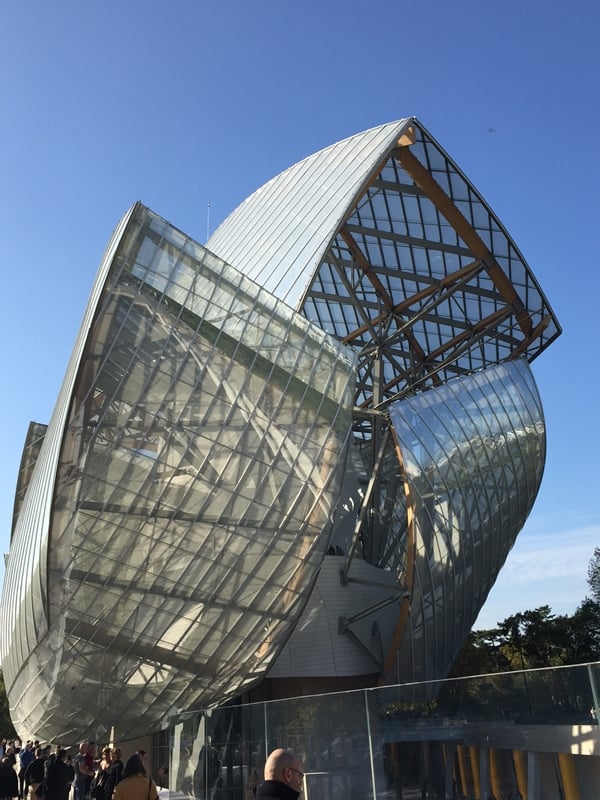Art & Exhibitions
As a Museum, Frank Gehry’s Fondation Louis Vuitton in Paris Disappoints
It's boring, safe, sanitized—a handbag palace on steroids.

It's boring, safe, sanitized—a handbag palace on steroids.

Benjamin Genocchio


Fondation Louis Vuitton, Paris.
It’s the Sydney Opera House crossed with a blimp. So what happened here? The problem with this building, for me, is that it is so corporate, so safe, so sanitized in terms of its design and the art on display, while at the same time trying to be cool, that you come away from a hopeful visit to the new $143 million Fondation Louis Vuitton museum in Paris feeling as if you have stepped out of a luxury retail store with a glass, mirrored interior courtesy Peter Marino.
It’s a shopping space sheathed in a prophylactic of art and creativity, an unimaginative building masked to look like an interesting and daring one. Not so long ago the fashion business swallowed the art world, and here, along with Art Basel in Miami Beach, is the apotheosis of that fatal absorption—everything that is radical, challenging, dirty, and difficult about contemporary art has been stripped away to reveal a handbag palace on steroids, complete with a bejeweled LV monogram on the outside entry wall.
The building was commissioned by Bernard Arnault, the chairman and chief executive of the luxury goods empire LVMH Moët Hennessy Louis Vuitton. It was envisaged as a contemporary art museum and performing arts center, a private museum in a country in which, well, there aren’t many private museums. That much is to be applauded and is even visionary. We are all better off for the establishment of this new public enterprise which will eventually be donated to the French republic. Bravo to Arnault and LVMH for that. And yet the corporate identity of the institution and its current funding model over-determine the entire look and feel of the place, not to mention its mission. Visiting the museum with a crowd of eager Parisians and tourists, I felt caught up in a publicity stunt more akin to the launch of a new fashion line or label than a serious endeavor to collect, show and conserve contemporary art. I felt excited for a new museum and disappointed at the same time.
Frank Gehry is the building’s architect. He has become a go-to guy for those looking to build signature museum buildings. The basic problem is that he has never equaled his Guggenheim Museum building in Bilbao; instead he has been churning out derivative, stripped-down designs for unimaginative, lazy clients looking for the image of innovation. Here the Fondation Louis Vuitton board knew what it was doing. In the business of building luxury brands, they wanted the appearance of innovation and creativity without actually having to provide or contend with it. This building is all about fashion, from the choice of the fashionable architect to the fashionable if mind-numbingly inoffensive art on display.

Fondation Louis Vuitton, Paris.
What about the art? Pierre Huyghe, Gerhard Richter, Thomas Schütte, Ellsworth Kelly, Bertrand Lavier, Taryn Simon, Sarah Morris, and Christian Boltanski are all good artists, sure, but what you have here for the opening display is the world’s most dull collection of their work. This stuff is so desperate not to make enemies, it’s going to have trouble making friends. Inside the Horizon (2014), a commission by Olafur Eliasson, is probably his least inspired and most forgettable artwork: 43 prism shaped columns of varying widths placed along the walkway in the grotto beside a water pool. Two of the sides are covered in mirrors and the third in a yellow blown glass, suggesting the work is all about reflections. It’s a piece of empty, light-driven decoration.
The museum itself is of questionable value as a functional space, because once you take away the exterior there are limited galleries, all of which look and feel a little awkward to me, with loads of glass and viewing areas designed more to admire the architecture than the art. Also, the lack of attention paid to movement and flow throughout the building is difficult to understand for an architect as experienced as Gehry—he is 85. A heralded reliance on “aerospace technology” and special 3-D software developed by Gehry Technologies (which made it possible to model complex shapes imagined for the exterior and is kind of interesting in a science-nerd sort of way) is redundant and irrelevant once inside, as everywhere image takes precedence over substance: Visitors struggle with limited restrooms, small elevators, and a tiny restaurant inadequate to the crowd capacity.
Bottom line is that it is hard to know where to go, or why, in this building, and even when you get there you are overwhelmed by a dispiriting sense of Why did I bother?

Olafur Eliasson’s installation at Fondation Louis Vuitton, Paris.